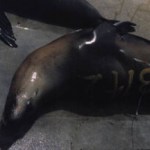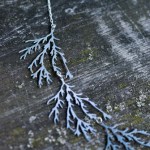algae
Image from the American Physiological Society's website.http://www.the-aps.org/mm/Conferences/APS-Conferences/2014-Conferences/…
As anticipated, the meeting today was excellent! Here are some highlights from today:
Dr. Michael Joyner (Mayo Clinic) spoke about how we should reconsider animal models that are used in research as laboratory rodents can be manipulated to match their genotype to their phenotype. In other words, researchers modify the animal's genome to produce a specific disease or attribute they are interested in studying. The problem with this approach is that genes can be…
Credit: Image courtesy of Stanford University Medical Center, from ScienceDaily
According to a press release from Stanford University, California sea lions develop epilepsy from exposure to a toxin produced by algae called domoic acid. The animals develop seizures which can result in memory loss, tremors, convulsions and even death. The hippocampal region in the brain of the affected sea lions shows similar damage as humans with epilepsy, with losses of about 50 percent of neurons. Dr. Paul Buckmaster, professor of comparative medicine at Stanford was quoted as saying, "We found there was…
Solar cells made with bismuth vanadate achieve a surface area of 32 square meters per gram. This compound can be paired with cheap oxides to split water molecules (and make hydrogen) with record efficiency.
Short-term geoengineering could postpone global warming, only to have it happen more quickly in the future.
Carotenoids tinge blackbird bills a deep orange, signalling fitness; birds with oranger bills are "are heavier and larger, have less blood parasites and pair with females in better condition than males with yellow bills."
Fibroblasts can extrude a tidy biological…
Algae filament necklace
Pam at Phantasmaphile alerted me to Nervous System, a jewelry company founded by MIT grads Jessica Rosenkrantz and Jesse Louis-Rosenberg. Nervous System "creates experimental jewelry, combining nontraditional materials like silicone rubber and stainless steel with rapid prototyping methods. We find inspiration in complex patterns generated by computation and nature."
While their various lines don't look quite as I expected - I was anticipating something Haeckel-like for "radiolaria" and neuronal for "dendrite" - they are intriguing and definitely "feel" organic.…
In late 2007, seabirds off the coast of California began to die in record numbers. The waterproof nature of their feathers and been wrecked, and they were soaked to the skin. Without an insulating layer of air trapped within their plumage, the damp birds were suffering from extreme cold. These are exactly the type of problems that seabirds face when they blunder into oil spills, but in this case, not a drop of petroleum had entered the water. The problem was a biological one.
At the same time, Monterey Bay in California was plagued by a massive "red tide" - a bloom of microscopic algae…
Solar power is a relatively new development for humans but, of course, many living things have been exploiting the power of the sun for millions of years, through the process of photosynthesis. This ability is usually limited to plants, algae and bacteria, but one unique animal can do it too - the emerald green sea slug Elysia chlorotica. This remarkable creature steals the genes and photosynthetic factories of a type of algae that it eats (Vaucheria littorea), so that it can independently draw energy from the sun. Through genetic thievery, it has become a solar-powered animal and a…
This is all Massachusetts needs--an invasion of rock snot:
Already a scourge in New Zealand and parts of the American South and West, the aquatic algae called "rock snot" is creeping into New England, where it is turning up in pristine rivers and alarming fishermen and wildlife biologists....
Over the past 10 years, the algae with a scientific name of Didymosphenia geminata, or didymo, has turned up in California, Washington, Alaska, Idaho, Montana, Nevada, Utah, Wyoming, Colorado, the Dakotas, Missouri, Arkansas and Tennessee....
The algae has the potential to bloom into thick masses with…
The Boston Globe reports that the Charles River swim race might be canceled because of cyanobacterial blooms. Again. So why is this happening? Phosphorous levels are too high:
Blue-green algae are not true algae, but cyanobacteria. They are usually present in amounts so small they are harmless, but can undergo exponential growth spurts when exposed to nutrients contained in contaminants such as lawn fertilizer and Canada goose droppings that wash into waterways.
State and federal environmental officials suspect that this year's bloom is occurring now because of optimal conditions for growth…
That's right--you heard it here first: algal blooms on the Charles River in Boston. Spake Universal Hub:
A blogger by the name of Mike the Mad Biologist, proving why we should get all our news from Technorati and Google Blogsearch, scoops the Globe by more than a week on the story (hmm, if a blogger posts in the Charles when nobody's around, does he still get coated in green slime?).
What's really sad is that none of the crack reporters at the Globe cared or knew that the water in the Charles River was fluorescent green for at least a week. Next time, you guys might want to check that out…
I was at the Esplanade in Boston, and I noticed something very weird in the water. By the Fairfield St. entrance, the water under the bridge and by the shore (on both sides, river and 'canal') was bright green, as if someone had dumped dye or paint in the water. When I got real close and then fished out some of the green water, I noticed that it wasn't die or paint at all, but tiny (1mm) algal colonies (I think). I have no idea what kind of algae they were (sorry, I didn't have my dissecting microscope handy). If there are any other Bostonian readers, have you seen this? And whom does…



